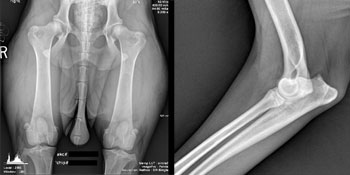ORTHOPEDICS - Overview of orthopedic conditions in the Bernese Mountain Dog Breed

Structural defects in joints can limit mobility and cause pain for some Berners. Hip dysplasia (HD) is a progressive, degenerative disease involving malformation of the hip socket joint. HD ranges from very mild with no apparent effects, to severe requiring surgical correction or euthanasia. Hip dysplasia appears to have both genetic and environmental causes. The term 'hips clear' is often utilized to imply a dog is structurally sound.
Hips aren't the only boney structure that can be unsound. Current data suggests that in the Bernese Mountain Dog Breed, there may be more dogs experiencing lameness problems associated with elbow dysplasia (ED) and OCD of the shoulders than there are suffering from pain or lack of mobility due to arthritic changes in hip joints.
Causes for lameness in Berners are not limited to dysplasia in hips and elbows. Soft tissue injuries to ligaments and muscles can result in lameness, as can Panosteitis, a developmental condition that can affect puppies and causes pain in long bones during growth. Owners are advised to seek veterinary assistance if a puppy or adult Berner has any persistent lameness.
SOOOOO...What's the concern? IN A NUTSHELL - orthopedic diseases/conditions are not uncommon in large breed dogs - including the BMD. Orthopedic problems impact the dog's welfare - cause pain, largely from osteoarthritis, and loss of mobility, not to mention the costs for veterinary care to treat or manage orthopedic conditions can place great financial burdens and emotional distress on families who own affected dogs.
ORTHOPEDIC EVALUATIONS
The oldest organization for evaluating joint status is the Orthopedic Foundation for Animals OFA. Radiographs (X-rays) of a dog's hips or elbows are analyzed by board certified veterinary radiologists to determine the presence or absence of orthopedic disease. Hips or elbows deemed free of dysplasia will get a numbered OFA certificate with a rating of Fair, Good, or Excellent, for elbows a normal or affected. If there is evidence of dysplasia, no number is assigned. PennHIP also evaluates hip status.
An OFA # on a parent does NOT necessarily mean the offspring will have good joints, but breeding from parents not affected by orthopedic disease can reduce the incidence and severity of the condition in individual dogs and the Bernese breed as a whole.
Puppy buyers are encouraged to talk about orthopedic screening with any breeder from whom they are considering getting a puppy. Breeders should provide puppy buyers with verifiable evidence dogs used for breeding purposes have been screened (radiographed) for orthopedic disease.
Below see a link to an article covering orthopedic conditions that can affect Bernese Mountain Dogs.
Today's Veterinary Practice: Juvenile Orthopedic Disease in Dogs & Cats, Part 1: Musculoskeletal Development & Pediatric Bone Diseases
Also see HEALTH OVERVIEW for more information on orthopedics.